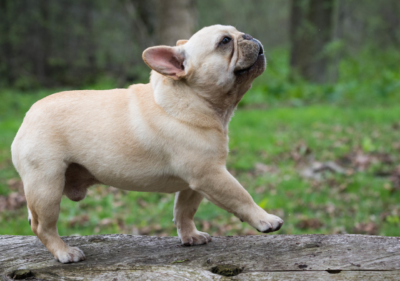IVDD In French Bulldogs: Best Tips On How To Help Your Dog?

If you would ask us to tell you what is one of the worst health conditions that can occur in Frenchies, we would definitely tell you it’s the IVDD. IVDD in French bulldogs is one of the most common health issues that require immediate and complicated treatment. If you started to notice some strange signs in your dog’s walking, then it’s the ultimate time to discover everything about this condition.
What is IVDD in French bulldogs?
Intervertebral Disc Disease (IVDD) is a common condition among French Bulldogs that affects the spinal cord, due to the degeneration of the cushioning discs between the vertebrae. This disease can lead to pain, nerve damage, and even paralysis. Understanding the anatomy and function of these discs is crucial for recognizing how IVDD develops in dogs. If you’re wondering how common is IVDD in Frenchies, then we have to disappoint you. Unfortunately, this health condition is relatively common in smaller dog breeds.
Symptoms of IVDD in French Bulldogs
French Bulldogs with IVDD may show signs of acute pain, unwillingness to jump, cry out unexpectedly, or exhibit neck or back stiffness. So, in case you’re noticed that your furry friend seems like he’s dealing with pains when trying to stand up, make sure you take him to the health check. IVDD in French bulldogs doesn’t occur only in senior pooches. It can occur even in younger adults.
Some dogs who suffer from intervertebral disc disease may also display changes in their posture, such as a hunched back or tucked abdomen, indicative of discomfort or severe pain.
Causes of IVDD in French Bulldogs
Genetic Predisposition
The primary cause of IVDD in French Bulldogs, as in many other breeds, is a genetic predisposition to disc degeneration. French Bulldogs have a genetic makeup that predisposes them to early degeneration of the intervertebral discs, which are supposed to cushion the vertebrae and absorb shocks. This degeneration leads to the discs becoming calcified, less flexible, and more susceptible to rupture or herniation under normal stress or minor trauma.
Similar genetic predispositions are seen in Dachshunds, which are perhaps the most well-known breed for suffering from IVDD. Dachshunds have an elongated spine and short rib cage, a phenotype known as chondrodystrophy, which significantly increases their risk of spinal issues. English Bulldogs also share this chondrodystrophic trait, making them similarly vulnerable to IVDD. The structural stresses imposed by these physical traits contribute to the higher incidence of IVDD among these breeds.
Physical Structure and Body Weight
The body structure and weight of a breed also play crucial roles in the development of IVDD. French Bulldogs are compact and muscular with a heavy bone structure, which puts additional stress on their spine. Overweight dogs are at a higher risk, as excess body weight further increases the stress on their spinal column and discs, accelerating the degeneration process.
This issue is similarly critical in English Bulldogs, which tend to have robust and compact bodies that can contribute to spinal stress if not maintained at a healthy weight. Dachshunds, with their long torsos, are especially vulnerable to spinal issues if they become overweight, as their spine must support more weight relative to its length.
Age and Lifestyle Factors
Age is another significant factor in the development of IVDD. As French Bulldogs age, the risk of disc degeneration increases due to natural wear and tear on the spinal column and its associated structures. This aging process is universal across all breeds, but those genetically predisposed to IVDD may experience symptoms at a younger age.
Lifestyle factors also contribute to the risk of developing IVDD. Dogs that engage in activities involving jumping or intense physical activity can have an increased risk of spinal injuries, which can precipitate or worsen IVDD. This is true across all susceptible breeds, but especially so for those with inherent structural vulnerabilities like French Bulldogs, Dachshunds, and English Bulldogs.
Environmental and Nutritional Factors
Environmental and nutritional factors also influence the development of IVDD. Adequate nutrition can help maintain a healthy weight and support skeletal health, reducing the burden on the spine. Conversely, nutritional deficiencies can exacerbate the risk of degenerative diseases like IVDD.
Diagnosing IVDD in French Bulldogs
Diagnosing Intervertebral Disc Disease (IVDD) in French Bulldogs involves a multifaceted approach. It combines clinical examination, symptom observation, and advanced imaging techniques. Early and accurate diagnosis is critical for effective treatment and can significantly impact the overall prognosis of the condition.
Clinical Examination and Symptom Observation
The diagnostic process usually begins with a detailed clinical examination by a veterinarian. During this examination, the vet will assess the dog’s gait, posture, pain response, and neurological reflexes. French Bulldogs exhibiting symptoms of IVDD may show signs of pain when their spine is touched. They may appear stiff, or might have difficulty standing or walking. Neurological signs, such as dragging the feet or inability to coordinate movement, are particularly indicative of more advanced stages of IVDD.
Medical History and Physical Indicators
A thorough medical history is essential for diagnosing IVDD. Veterinarians will inquire about any incidents that might have precipitated symptoms, such as falls or jumping injuries, as well as the duration and progression of the symptoms. This history helps in distinguishing IVDD from other conditions that can present with similar symptoms, such as hip dysplasia or tumors.
Advanced Imaging Techniques
Advanced imaging is crucial for a definitive diagnosis of IVDD. These techniques include:
- X-rays: X-rays can help in identifying changes in the spacing between vertebrae, presence of bone spurs, or calcification of the discs. However, while useful, X-rays alone are not sufficient to diagnose IVDD since they do not provide detailed images of soft tissues.
- Magnetic Resonance Imaging (MRI): MRI is considered the gold standard in diagnosing IVDD. It provides detailed images of both the hard and soft spinal structures, including the discs, spinal cord, and surrounding tissues. MRI is particularly useful for assessing the degree of disc protrusion or herniation and the extent of any spinal cord compression.
- Computed Tomography (CT) Scan: CT scans are sometimes used as an alternative to MRIs. They are especially good at visualizing the bone structures of the spine but are less effective than MRIs at imaging soft tissues. However, CT scans can be combined with a myelogram—a procedure that involves injecting a contrast dye into the spinal column—to better visualize the spinal cord and locate any compressions.
Types of IVDD in French Bulldogs: Understanding Hansen Types
Intervertebral Disc Disease (IVDD) in French Bulldogs can be classified into two main types based on the classification system developed by Dr. Björn Hansen. These types are known as Hansen Type I and Hansen Type II, and they differ significantly in their pathology, which affects the treatment approach and prognosis. Understanding these types helps veterinarians tailor their diagnostic and therapeutic strategies effectively.
Hansen Type I IVDD
Hansen Type I IVDD is characterized by an acute herniation of the disc material. In this condition, the inner part of the intervertebral disc, known as the nucleus pulposus, ruptures through the outer fibrous ring, called the annulus fibrosus. This rupture compresses the spinal cord. This type of disc disease is most commonly associated with chondrodystrophic breeds. These breeds have genetic traits that lead to early degeneration of disc material. French Bulldogs, known for their predisposition to early disc degeneration, are typically prone to this type of IVDD.
The onset of Hansen Type I is usually sudden, and the symptoms can be quite severe. Dogs might experience intense pain, paralysis, or paresis (partial paralysis), and the condition may deteriorate rapidly without prompt treatment. The acute nature of this type of IVDD often requires aggressive treatment. It might include surgical intervention to remove the herniated disc material and alleviate pressure on the spinal cord.
Hansen Type II IVDD
Hansen Type II IVDD involves a more gradual degeneration and protrusion of the disc material. In this type, the annulus fibrosus does not rupture. Instead, it bulges outwards and presses on the spinal cord over time. This type is more common in non-chondrodystrophic breeds or older dogs. Their disc material becomes harder and less elastic as part of the aging process.
The symptoms of Hansen Type II IVDD tend to develop more slowly and are often less severe compared to Type I. Treatment for Type II usually starts with conservative management, including anti-inflammatory medications, pain relief, and restricted activity. Surgical options may be considered if conservative treatments fail to relieve symptoms or if neurological functions deteriorate.
Treatment Options for IVDD
Surgical Treatments
In severe cases, surgery might be necessary to remove the damaged disc material pressing on the spinal cord. Surgical options vary based on the location and extent of the disc herniation.
Non-Surgical Treatments
For less severe cases, non-surgical methods such as anti-inflammatory medications, pain relievers, and cage rest may be recommended. It’s essential to monitor the dog’s recovery and adjust treatments as necessary.
Medications for IVDD
- Non-Steroidal Anti-Inflammatory Drugs (NSAIDs): These are typically the first line of medication used to manage pain and inflammation in dogs with IVDD. Drugs such as carprofen, meloxicam, and firocoxib are commonly prescribed. However, they must be used under veterinary supervision due to potential side effects on the liver and kidneys.
- Pain Relievers: For severe pain, veterinarians may prescribe opioids like tramadol. Muscle relaxants such as methocarbamol can also be used to reduce muscle spasms, which are common in IVDD.
- Corticosteroids: In some cases, corticosteroids may be prescribed to reduce severe inflammation. However, their use must be carefully managed because of potential side effects, including increased susceptibility to infections and gastrointestinal issues.
Supportive Care Products
- Orthopedic Dog Beds: An orthopedic French Bulldog bed is essential for dogs with IVDD. These beds provide extra support and cushioning for the spine, which can help alleviate pain and prevent further injury. The memory foam in these beds molds to the dog’s body. In that way, it reduces pressure points and provides warmth to soothe stiff joints.
- Hip Belts and Support Harnesses: Hip belts or support harnesses can be particularly useful for dogs with IVDD. These devices help support the dog’s lower back and abdomen. They also reduce strain on the spine and help to stabilize the back during movement. They can also make it easier for owners to lift and assist their dogs without causing further injury.
IVDD in French Bulldogs: Wrapping Up
Dealing with IVDD in french bulldogs definitely sound scary. However, with the right treatment, you’ll be able to ease pains in your little gremlin. Owners should monitor their pets closely for any signs of back pain or discomfort and maintain regular veterinary check-ups.







 French Bulldog Jackets & Coats
French Bulldog Jackets & Coats French Bulldog Dresses & Skirts
French Bulldog Dresses & Skirts French Bulldog Hoodies
French Bulldog Hoodies French Bulldog Sweaters
French Bulldog Sweaters French Bulldog Shirts
French Bulldog Shirts French Bulldog Pajamas
French Bulldog Pajamas French Bulldog Costumes
French Bulldog Costumes French Bulldog Life Jackets
French Bulldog Life Jackets

 French Bulldog Collars
French Bulldog Collars French Bulldog Harness
French Bulldog Harness
 French Bulldog Backpacks
French Bulldog Backpacks







